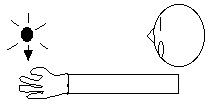![]()
|
|
![]()
|

Wrap the dowel in aluminum foil. Unscrew the back of the Mini-MagLite and remove one AA battery, replace the battery with the aluminum-foil wrapped dowel. Unscrew and remove the front of the Mini-MagLite. The light will come on as a dim point source. |
![]()
|
Turn the room lights on, or open the shades. Close your right eye. Hold the dim point-source of the Mini-MagLite in front of your nose, at arm's length. Move the light slowly to the left. Keep your left eye looking straight ahead, do not look at the light. At some point the light appears to go out as it enters your blind spot. If you move your eye to look at the light, it will once again be visible. Repeat the experiment with your right eye open and your left eye closed. Once you find your blind spot, map its shape by moving the light around and finding the edges of the region in which the light is invisible. Notice that even though the light disappears in your blind spot, you do not perceive a hole in the background where the light used to be.

|
![]()
|
The nerves that carry signals from your retina and its blood supply are in front of your retina. Light goes through them before it is detected. Both the optic nerve and the retinal blood supply pass through the retina at a place where there are no light detectors -your blind spot. Your eye and brain fill in the hole in your vision. You perceive your blind spot to be outside of center of your field of view. Your fovea is located at the center of your field of view. Your brain inverts images top-to-bottom and right-to-left. This means that the optic nerve actually connects to your retina inside of the center of your field of view. That is, on the nose side of your fovea. |
